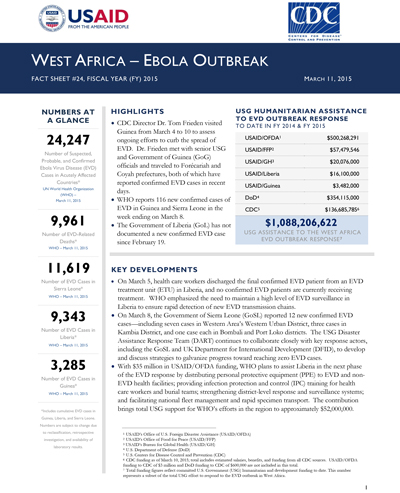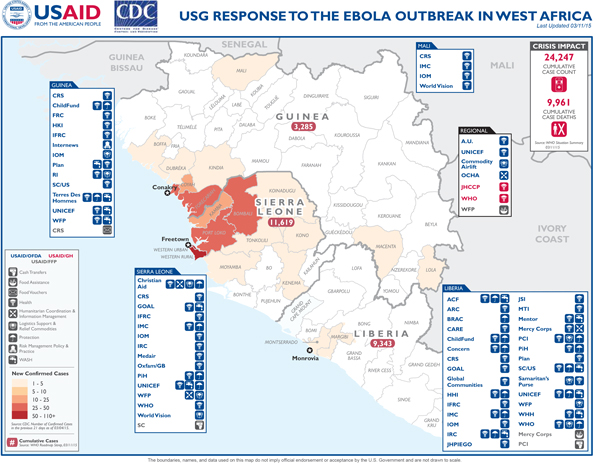Speeches Shim
March 18, 2015
HIGHLIGHTS
Ebola Response
Visit our main West Africa Ebola Outbreak page to learn more about how we're responding to the West Africa Ebola outbreak, and what you can do to help.
- WHO reports 150 new confirmed cases of Ebola Virus Disease (EVD), including 95 cases in Guinea and 55 in Sierra Leone, during the week ending on March 15. The week marks Guinea’s highest weekly recorded total during 2015.
- All contacts associated with the last known chain of transmission in Liberia have completed the 21-day monitoring period.
- The EVD outbreak has resulted in nearly 10,200 deaths to date in Guinea, Liberia, and Sierra Leone.
West Africa Ebola Outbreak Fact Sheet #25 (FY 15) ![]() (pdf - 379k)
(pdf - 379k)
KEY DEVELOPMENTS
- In the week ending on March 15, the Government of Liberia (GoL) reported 125 suspected and probable EVD cases—however, of these reported cases, zero tested positive for EVD, according to WHO. The continued reporting of suspected and probable EVD cases demonstrates ongoing disease surveillance and vigilance among response actors. The GoL has not documented a new confirmed EVD case since February 19.
- EVD response actors are preparing for the May–October rainy season, which may result in poor road conditions that impede travel and disrupt supply chains. In coordination with government officials, USAID/OFDA partners in Guinea, Liberia, and Sierra Leone are developing contingency plans; assessing storage capacity and pre-positioning items such as personal protective equipment (PPE), medical supplies, and fuel at health facilities; and supporting infrastructure upgrades to EVD care facilities to mitigate possible risks from heavy rainfall.
- USAID/OFDA recently committed approximately $14.9 million to support EVD response activities in Guinea through partner International Medical Corps (IMC). The new funding brings the total USG contribution to the EVD response to more than $1.1 billion.
REGIONAL
- On March 13 and 14, representatives from the governments of Guinea, Liberia, and Sierra Leone, along with infection prevention and control (IPC) professionals and a USAID/OFDA technical advisor, met in Freetown, Sierra Leone. Discussions focused on developing guidance for decommissioning EVD care facilities in the region. Prior to the meeting, staff from CDC, WHO, and the UN Children’s Fund (UNICEF) developed a draft document. CDC and UN officials plan to incorporate input from the Freetown meeting and anticipate releasing final guidance on decommissioning EVD treatment facilities on or around March 31.
West Africa Ebola Map #25 March 18, 2015 ![]() (pdf - 543k)
(pdf - 543k)
Liberia
Following the February 22 reopening of Liberia’s land borders with Guinea and Sierra Leone, the GoL prioritized training on community surveillance and the newly developed standard operating procedures for border-control officials in five counties, including Bong, Gbarpolu, Grand Cape Mount, Lofa, and Nimba. CDC staff, in close coordination with USAID/OFDA partners Global Communities and the International Organization for Migration (IOM), facilitated the inaugural training event in Grand Cape Mount’s Sinje town on March 12 and 13. CDC field teams also assessed EVD prevention activities at 18 border crossings and 26 health clinics across the five counties between March 7 and 17.
USG Disaster Assistance Response Team (DART) and CDC staff members traveled to Nimba County on March 11 and 12 to observe county-level coordination efforts and assess emergency management capabilities. To complement the national emergency operations center (EOC), the CDC Foundation is supporting the construction of 15 county-level EOCs to enhance coordination among GoL and EVD response actors.
CDC, in coordination with USAID/OFDA partners WHO and Jhpiego, is also implementing an IPC mentorship program in Nimba with staff from six health facilities. Between March 15 and 22, CDC staff are making daily supportive supervision visits to a health clinic to train clinical staff on IPC protocols, including screening procedures, proper hand-washing techniques, and PPE use.
During the week of March 9, a USAID/OFDA-supported helicopter arrived in Liberia; the helicopter will become operational in the coming days following a series of test flights. Operated by IMC, the helicopter will provide medical evacuation and personnel and specimen transport services across the country, enabling IMC to swiftly respond to potential EVD hotspots, especially in border areas.
Sierra Leone
From March 2 to 15, the Government of Sierra Leone (GoSL) reported 107 new confirmed EVD cases, including cases in Bombali, Kambia, Koinadugu, Port Loko, Western Rural, and Western Urban districts. A confirmed case in Koinadugu on March 11 was the first new confirmed case in the district in 14 days. The district’s remote location, poor telecommunications infrastructure, and relatively limited response resources would likely pose unique response challenges in the case of a large EVD outbreak, according to the GoSL and CDC. The GoSL, CDC, WHO, and non-governmental organizations (NGOs) are working to reduce further transmission in Koinadugu through rapid case investigation and thorough documentation of contacts.
A U.S. health care worker in Sierra Leone tested positive for EVD and returned to the United States for care on March 13, with additional health care workers who had contact with the patient under medical supervision, according to media sources. CDC deployed additional staff to Sierra Leone to investigate the EVD exposure.
On March 14, Sierra Leonean President Ernest Bai Koroma approved a new national EVD response strategy intended to reinvigorate efforts to reach zero new EVD cases in the country. The GoSL National Ebola Response Center led the strategy development and will coordinate implementation in collaboration with key government, UN, donor, and NGO stakeholders. The strategy’s three components include critical response interventions, event management, and national prevention and treatment campaigns. The response strategy also includes a “Getting to Zero” campaign focused on hotspot districts; the GoSL plans to begin the campaign—which includes stay-at-home periods to enable door-to-door community engagement—in late March.
DART staff visited Kambia District on March 11 to assess ongoing EVD response activities and challenges. The GoSL remains concerned regarding possible cross-border EVD transmission from Guinea’s Forécariah Prefecture, which borders Kambia to the north. While in Kambia, the DART met with CDC staff, USAID/OFDA partners, and UN and GoSL representatives to discuss identified response challenges, including ineffective social mobilization and inadequate surveillance capacity, and planned activities to combat these challenges.
With USAID/OFDA support, UNICEF is assisting EVD survivors and others affected by the outbreak throughout Sierra Leone. To date, UNICEF has facilitated six survivor conferences, reaching approximately 650 survivors who also received follow-up psychosocial support and relief commodities, such as clothing, mattresses, and hygiene items. UNICEF is also working with NGOs to provide family tracing and reunification (FTR) and psychosocial support. To date, the FTR network has identified and registered more than 8,440 children who lost one or both parents to EVD; registered and assisted nearly 10,400 children and their families with psychosocial support services; and reunified more than 1,500 unaccompanied or separated children with their families.
Guinea
The Government of Guinea (GoG) and WHO reported 29 new confirmed EVD cases on March 14 and 15, including 16 cases in Forécariah, eight in Coyah Prefecture, and five in the capital city of Conakry. Response actors report that the recent caseload increase in Coyah and Forécariah is likely linked to improved EVD surveillance due to reduced community reticence. CDC staff note that most cases confirmed in Conakry come from chains of transmission in Forécariah.
Three doctors working at the Ignace Deen hospital in Conakry tested positive for EVD during the week of March 9. In response, health actors are working to reinforce IPC protocols at the hospital.
As of March 17, health actors were treating 90 people, including 61 confirmed cases and 29 suspected cases, in Guinea’s EVD treatment centers—an increase of nearly 110 percent since March 1, when health actors were treating 43 people.
WHO recorded 41 EVD-related deaths in Guinea in the week ending March 15; of those, 23 deaths occurred in communities and 18 involved unsafe burials. These indicators suggest that unknown chains of transmission continue to drive the outbreak in Guinea, according to WHO.
An EVD treatment unit (ETU) released two recuperated EVD patients from Macenta Prefecture on March 9. However, despite sensitization efforts by response actors, the patients’ family members and neighbors are refusing to accept the survivors back into the community—highlighting ongoing stigmatization-related challenges impeding EVD response activities in Guinea. CDC and WHO continue to conduct contact tracing activities and have not confirmed additional EVD cases in Macenta since the two patients were confirmed positive for EVD on February 24 and 26.
CDC, in coordination with WHO and the GoG, is improving EVD-related data collection and analysis. Following CDC Director Dr. Tom Frieden’s visit to Forécariah on March 5, CDC staff traveled to the prefecture on March 10 to assess the current information technology systems used to log EVD data. CDC and WHO representatives are supporting Forécariah surveillance staff to improve database management—a critical component to improving response efforts, particularly as some EVD cases previously confirmed in Forécariah reportedly did not come from known contact lists.
In response to ongoing EVD transmission in Forécariah, USAID/OFDA partner the French Red Cross (FRC) is working to transform the current 14-bed EVD transit center in the prefecture into a 30-bed ETU in the coming days.
With a new commitment of $14.9 million from USAID/OFDA, IMC is constructing and supporting transitional screening and referral units at 10 hospitals throughout Guinea. The semi-permanent structures will provide screening, temporary isolation, and safe referrals of suspected EVD patients. IMC will also train hospital staff on IPC measures and basic psychosocial support for EVD-affected individuals; work to raise community awareness of EVD transmission and prevention practices; and deploy rapid response teams, as needed, to potential EVD hotspots.
PUBLIC DONATION INFORMATION
- The most effective way people can assist relief efforts is by making cash contributions to humanitarian organizations that are conducting relief operations. A list of humanitarian organizations that are accepting cash donations for disaster responses around the world can be found at www.interaction.org.
- USAID encourages cash donations because they allow aid professionals to procure the exact items needed (often in the affected region); reduce the burden on scarce resources (such as transportation routes, staff time, and warehouse space); can be transferred very quickly and without transportation costs; support the economy of the disaster-stricken region; and ensure culturally, dietary, and environmentally appropriate assistance.
More information can be found at:
- The Center for International Disaster Information: www.cidi.org or +1.202.821.1999.
- Information on relief activities of the humanitarian community can be found at www.reliefweb.int.
USAID/OFDA bulletins appear on the USAID website at what-we-



Comment
Make a general inquiry or suggest an improvement.